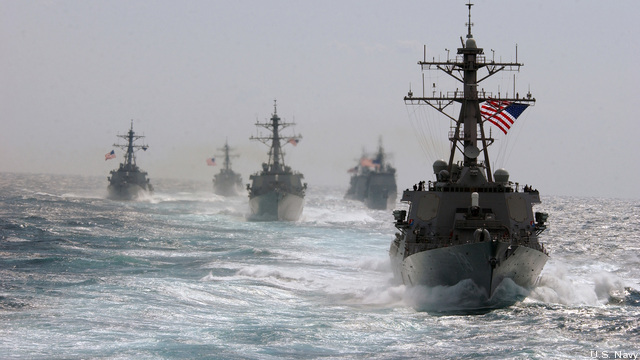Many Ships = Few Wars: The Case For A Big Fleet
Posted on

Aegis cruisers and destroyers.
WASHINGTON: Think of international conflicts as earthquakes. Many little ones are better than one “Big One” — a global war. Social science suggests that the more often two rival powers interact, the more likely they are to resolve their differences through many small, manageable conflicts rather than one violent conflagration. That makes naval presence worldwide a very desirable capability, two US Navy officers write in a recent paper.
It takes lots of ships to create a track record of standing firm in the face of provocations such as China’s assertive moves versus ships, aircraft, and shoals in the South China Sea. It takes lots of ships to have lots of interactions where rival powers can test each other in low-stakes settings and thus lower the risk of one big war. The problem is, we don’t have lots of ships anymore.
“Numbers are so important to preserving the peace,” retired Navy Capt. Jerry Hendrix told me, speaking only for himself and not his active-duty co-author, Cdr. Benjamin Armstrong. “We haven’t been in this situation with a Navy this small before. The system is beginning to unravel.”

Jerry Hendrix
“The daily interactions provided by naval presence act to demonstrate the boundaries of US interests and levels of US resolve, decreasing the potential for misunderstandings and the outbreak of conflict.,” write Hendrix and Armstrong in their Center for a New American Security study, “The Presence Problem: Naval Presence and National Strategy.” Conversely, they continue, “a decrease in naval presence brought on by the downsizing of the Navy and Marine Corps…would result in a greater probability of friction, conflict, and war as the extent of American interests fall into question.”
Hendrix and Armstrong speak to the heart of a hot debate in and around the US Navy. Within a limited budget, should the service prioritize large numbers of smaller ships to provide peacetime presence or small numbers of powerful ships to prepare for future war? Navy leaders and the Defense Secretary are wrestling with the right balance, with the lightweight Littoral Combat Ship particularly at stake. Hendrix and Armstrong argue, however, that we’re trying to make these tough decisions without a clear idea of what presence is, let alone what presence is for.
The lack of intellectual clarity is not borne of a lack of practical experience. The US Navy has had ships in the Pacific, for example, almost continuously since 1800. Even at the height of the Civil War, Abraham Lincoln left the Pacific Squadron on station, Hendrix and Armstrong write, because he believed that presence had to be maintained. Teddy Roosevelt’s “Great White Fleet” of battleships — generally consisted pure warfighters — performed disaster relief in Italy. Today, Navy Secretary Ray Mabus insists that providing presence around the world is “the most important accomplishment that we’ve had.”
So we know presence is important — but why? “Despite the long history of…naval presence operations, there is little discussion of the strategy or theory of why these kinds of missions are worth pursuing,” Hendrix and Armstrong write. “Naval presence all too often appears to mean that at any given time the Navy will have a certain number of ships bobbing around on the world’s oceans waiting for things to happen.”
In fact, ships on “presence” duties are constantly performing one mission or another: exercises with friendly nations, showing resolve to hostile ones, building goodwill with humanitarian assistance and port visits, training their own crews in any available moment, so on. But naval theorists typically focus on fleet battles, wartime convoys, and commerce raiding, not operations that stop short of violence. “Naval thinkers have to start working on better ways to measure and record the benefits of naval presence,” Hendrix and Armstrong write.
The theoretical framework the two authors propose has as its foundation a 1996 computer simulation of — surprisingly enough — sand piles. If you add sand to an existing pile, no matter how steadily you pour, eventually there’ll be an abrupt collapse, a mini-avalanche as some accumulated imbalance becomes too much for the structure to bear. Danish physicist Per Bek calculated the best way to minimize such large disruptions is to create constant small disruptions, for example by gently vibrating the table underneath the pile.
Bek’s “self-organizing criticality” model has since been applied to complex, disaster-prone systems from earthquakes to forest fires to wars. In Hendrix’s and Armstrong’s analogy, global naval presence provides the constant vibration to the sand pile of geopolitics, letting instabilities sort themselves out in many minor events rather than a single catastrophic one.
“The theory suggests that the more interactions there are between nations, the more opportunities there are to demonstrate national interests: what you stand for and perhaps more importantly, what you will not stand for,” Hendrix told me. “Interactions allow nations to bleed off tensions continuously rather than infrequently and catastrophically.”
So what does this theory suggest about the kind of fleet we should build? Arguably, it underlines the importance of “balance,” the guiding principle for the new Chief of Naval Operations, Adm. John Richardson.
There’s a “vital balance between preserving the peace and winning the war,” Hendrix told me. “If we build only high-capability ships, we will not have enough money to build enough of them to be where we need to be to preserve the peace. If, on the other hand, we build too many low-end platforms, the fleet will not be capable of winning the war and hence will not have sufficient conventional deterrent power to preserve the peace. A fleet of around 350 ships seems about right, and I think LCS will be a part of that fleet’s balance.”
Subscribe to our newsletter
Promotions, new products and sales. Directly to your inbox.
